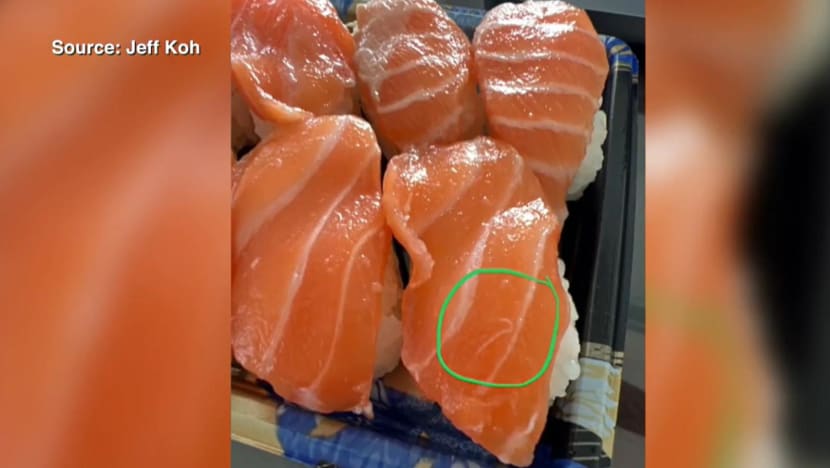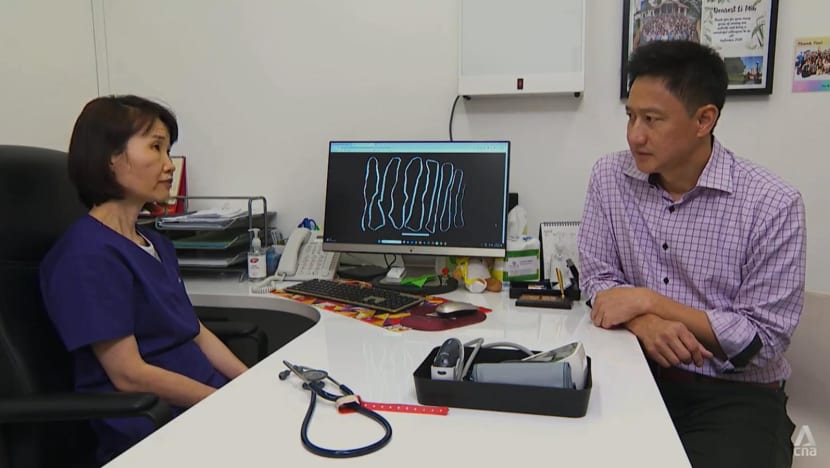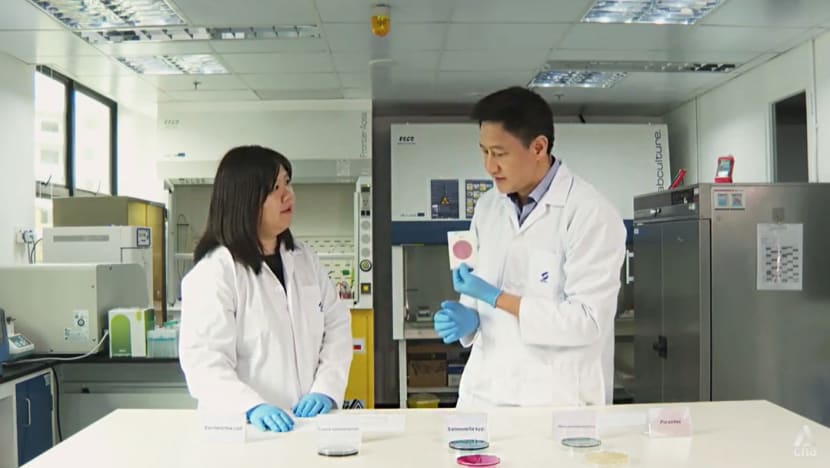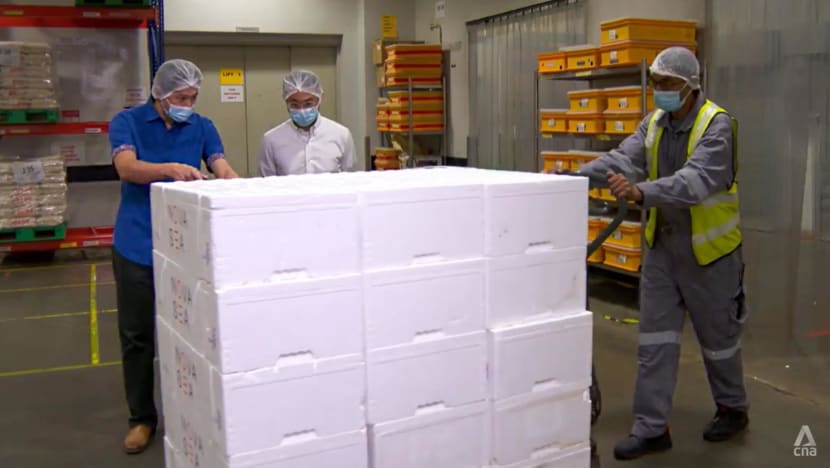Love sashimi but afraid of ingesting worms? Here are some tips for eating ‘high-risk’ raw fish
After incidents where consumers found worms in their sashimi, the programme Talking Point did a small experiment on the safety of sushi sold in Singapore. A veteran chef also shares tips on checking for parasites before indulging in raw fish.

Talking Point host Steven Chia will keep eating sushi but pay more attention to each slice before tucking in.
SINGAPORE: He was in the mood for sushi, so TikTok user Jeff Koh bought some from a popular take-out store in Woodlands two months ago.
“The store is always crowded, with a long queue, and I trusted their hygiene (standards),” he said.
But when he arrived home, he discovered what looked like “a few” white worms on the raw fish slices, or sashimi.
He posted a clip of his discovery on TikTok and tagged the sushi retailer and media outlets, asking what consumers who find parasites in their take-out sushi should do.
While the incident hasn’t put Koh off sashimi, he has changed his eating habits. He now goes to “a proper Japanese restaurant” to have his fill of the dish.
“And I usually will take a closer look at the raw salmon to see if there (are) any parasites or worms on it. I would just flip … the sushi,” he said.

There’s more that consumers can do. Experts and industry players share tips on the CNA programme Talking Point, which also conducted a small experiment to look into how safe it is to eat raw fish in Singapore.
HOW DO THE WORMS GET INSIDE THE FISH?
Raw fish may be commonly eaten here, but the Singapore Food Agency (SFA) considers it a “high-risk food” as it does not go through a cooking process.
“Besides microbiological contamination, the consumption of ready-to-eat raw fish also carries a risk of contracting parasitic diseases," the agency told CNA in February, after another consumer found a parasitic worm in her sashimi rice set from a Japanese discount chain store.
WATCH: We test salmon sashimi from 15 stores for food safety (4:28)
Two of the more common parasitic worms are roundworms — such as the Anisakis — and tapeworms.
An adult parasitic worm first lays eggs in the intestine of a host such as a dolphin.
Its eggs are passed out in the faeces of the host and hatch into free-swimming larvae, said Republic Polytechnic environmental and marine science lecturer Marie Tan.
The larvae swim around looking for their next host. They could be eaten by a prawn, which is in turn eaten by a fish.
And if the fish gets eaten by a human, the human would become “an accidental host to the parasite”, said Tan.
Parasitic worms are “quite common” in fish, especially wild-caught ones, she said. They are less likely to occur in farmed fish, which grow in more controlled conditions.

WILL I KNOW IF I’VE EATEN A WORM?
Consumers who have inadvertently eaten Anasakis worms could experience a range of symptoms including nausea, vomiting, diarrhoea and loose stools, said infectious disease specialist Ling Li Min of Rophi Clinic.
Some may pass out blood in their stools but, most of the time, these symptoms are hard to tell apart from regular food poisoning, she said.
Another fish parasite that consumers of raw fish could ingest is tapeworm, which can grow to lengths of a whopping two or three metres. People may be unaware they have ingested tapeworms, said Ling, who treated three tapeworm infections last year.

They may show no symptoms such as diarrhoea or nausea until they “find something … crawling in (their) stools”, she said.
Tapeworms do not immediately cause life-threatening diseases, but could cause problems should they remain in humans, she added. “Remember — it latches on to the intestine, so it’s going to interfere with nutritional absorption. All of this is going to give rise to general poor health.”
This is why individuals should seek medical help, she added.
As scary as parasitic worms can be, they are “thankfully, not at all common” among patients Ling sees. Food poisoning caused by bacteria such as Salmonella, Escherichia Coli (E. Coli), Vibrio and Listeria monocytogenes is “much more common”.
15 SAMPLES OF SALMON SASHIMI TESTED, ONE FAILS
To test the safety of sushi sold in Singapore, Talking Point sent 15 samples of salmon sashimi from various sources — online grocers, supermarkets and budget to high-end eateries — to a laboratory.

The samples were tested for parasites as well as Salmonella, E. Coli, Vibrio parahaemolyticus and Listeria monocytogenes. In healthy people, these bacteria may cause minor illness, said Ling. But in people with compromised immunity, the consequences could be severe or life-threatening.
Ling singled out Listeria for its potential to cause severe illness and even miscarriage in pregnant women.
No parasite was found in the 15 samples. The tests revealed contamination in two of the samples. But only one sample, purchased from a budget-friendly joint, was unfit for consumption due to the presence of Listeria. According to Singapore food regulations, the bacterium must not be detected in ready-to-eat food.
The other sample, from an online grocer, contained an acceptable level of E. Coli. At 20 colony forming units per gram, this was lower than the 100 colony forming units per gram limit for solid food set by the authorities, explained Agnes Ye, senior manager and head of the microbiology department at test and inspection company Setsco Services.

E. Coli can end up in food due to food handlers not washing their hands properly, said Ye.
Listeria, a cold-loving bacteria that can survive even in a refrigerator, can find its way into food at any point along the supply chain, she said. “For example, if the table is dirty and you put your fish on it. … Subsequently, when you package the fish, the bacteria can still remain in it.”
By right, none of these bacteria should be found in all the 15 samples that were tested.”
The SFA recommends buying ready-to-eat raw fish from licensed establishments only.
Consumers can make raw fish the final item they put in their shopping basket and keep it in an insulated bag, according to guidelines issued in 2021 by the agency Enterprise Singapore and the Singapore Standards Council.
They should place the fish in a chiller at temperatures between zero and four degrees Celsius as soon as possible after purchase, and follow instructions on the package on how to handle and store the item. Before and after handling the fish, they should wash their hands and utensils thoroughly. They should not refreeze items that have thawed.
WATCH: The full episode — Are my sashimi and raw fish safe to eat? (21:30)
EATING OUT? HERE’S HOW TO CHECK YOUR SASHIMI
For people dining out, chef Koezuka Yoshihiko, the general manager of Kuriya Dining, has some tips on reducing the chances of eating sashimi that contains worms.
Demonstrating with a kampachi, or yellowtail flown in from an Osaka fish market, Yoshihiko told Talking Point host Steven Chia that “transparent” eyes on a fish indicate freshness.
Worms tend to be found in the intestines of fish, so Kuriya Dining's imports have already had their guts removed in Japan.
Diners should check the surface of the fish they are going to eat, as well as check between the sliced fillets. They should also ensure there are no holes in the flesh and, finally, check for firmness, said Yoshihiko. “If there are worms inside or if the fish is not fresh, the flesh may be a little bit soft.”

Although the SFA recommends entities importing and processing ready-to-eat raw fish do deep-freezing, many do not because deep-freezing affects its texture. But licensed importers have traceability measures and various practices in place.
They apply for a cargo clearance permit each time they import fish, said Kenny Ng, vice-president of the central kitchen of food services company RE&S Enterprises. This ensures should food incidents occur, companies know “exactly which batch it came from”.
Throughout the transportation process, the fish is kept at temperatures below four degrees Celsius, Ng added.

Carton boxes that arrive at RE&S’ headquarters are inspected to ensure they aren’t broken. As part of the company’s procedures, samples are taken from the processing line and sent to the company’s quality assurance laboratory to undergo tests to ensure that any bacteria found are below thresholds set by the authorities.
Fish that pass the inspections are cleaned and sliced, then packed and sent to restaurants. Labels indicate expiry dates, and any leftovers will be discarded by the restaurants, Ng said.
Watch this episode of Talking Point here. The programme airs on Channel 5 every Thursday at 9.30pm.
Read this story in Bahasa Indonesia here.
Read this story in Bahasa Melayu here.








